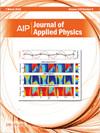Molybdenum disulfide under extreme conditions: An ab initio study on its melting
IF 2.5
3区 物理与天体物理
Q2 PHYSICS, APPLIED
引用次数: 0
Abstract
Crystalline molybdenum disulfide has become a central actor in the 2D-materials community due to its promising optoelectronic and thermoelectric properties. Despite the extensive work made in investigating these properties, a vast area of knowledge remains unknown on the structure and dynamics of its disordered phases such as liquid and amorphous. Thus, the goal of this work is to investigate the melting of bulk molybdenum disulfide using ab initio molecular dynamics based on density functional theory. We employ the two-phase and Z-methods to evaluate the melting in a number of conditions. Our results at 1 bar reveal that the two-phase procedure is preferred since it predicts a melting point of 2266.92 K that is directly computed using simulations at constant pressure and energy. In contrast, this temperature is indirectly estimated at 2154.01 K with the Z-method using an interpolation of simulations at constant volume and energy. Nevertheless, we find that both methods are complementary as they allow computing different thermodynamic and structural properties. For instance, we estimate a melting heat of 0.67 eV/atom with the two-phase coexistence route, which shows very good agreement with the value of 0.75 eV/atom obtained from the difference of the internal energies of separate crystalline and liquid ensembles at the same conditions of 1 bar and 2266.92 K. In contrast, the Z-method allows us to determine the influence of pressure on the melting temperature, density, and coordination number with a lower computational cost.极端条件下二硫化钼熔炼的从头算研究
结晶二硫化钼由于其良好的光电和热电性能,已成为2D材料界的核心参与者。尽管在研究这些性质方面做了大量工作,但关于其无序相(如液体和非晶态)的结构和动力学,仍有大量知识未知。因此,本工作的目标是利用基于密度泛函理论的从头算分子动力学研究大块二硫化钼的熔融。我们采用两相法和Z法来评估多种条件下的熔融情况。我们在1的结果 条形图显示,两相程序是优选的,因为它预测的熔点为2266.92 K,这是在恒定压力和能量下使用模拟直接计算的。相比之下,该温度间接估计为2154.01 K,Z方法使用在恒定体积和能量下的模拟插值。然而,我们发现这两种方法是互补的,因为它们允许计算不同的热力学和结构性质。例如,我们估计熔化热为0.67 eV/原子与两相共存路线,这与0.75的值显示出非常好的一致性 eV/原子,由在1的相同条件下分离的晶体和液体系综的内能之差获得 bar和2266.92 K.相反,Z方法使我们能够以较低的计算成本确定压力对熔融温度、密度和配位数的影响。
本文章由计算机程序翻译,如有差异,请以英文原文为准。
求助全文
约1分钟内获得全文
求助全文
来源期刊

Journal of Applied Physics
物理-物理:应用
CiteScore
5.40
自引率
9.40%
发文量
1534
审稿时长
2.3 months
期刊介绍:
The Journal of Applied Physics (JAP) is an influential international journal publishing significant new experimental and theoretical results of applied physics research.
Topics covered in JAP are diverse and reflect the most current applied physics research, including:
Dielectrics, ferroelectrics, and multiferroics-
Electrical discharges, plasmas, and plasma-surface interactions-
Emerging, interdisciplinary, and other fields of applied physics-
Magnetism, spintronics, and superconductivity-
Organic-Inorganic systems, including organic electronics-
Photonics, plasmonics, photovoltaics, lasers, optical materials, and phenomena-
Physics of devices and sensors-
Physics of materials, including electrical, thermal, mechanical and other properties-
Physics of matter under extreme conditions-
Physics of nanoscale and low-dimensional systems, including atomic and quantum phenomena-
Physics of semiconductors-
Soft matter, fluids, and biophysics-
Thin films, interfaces, and surfaces
 求助内容:
求助内容: 应助结果提醒方式:
应助结果提醒方式:


